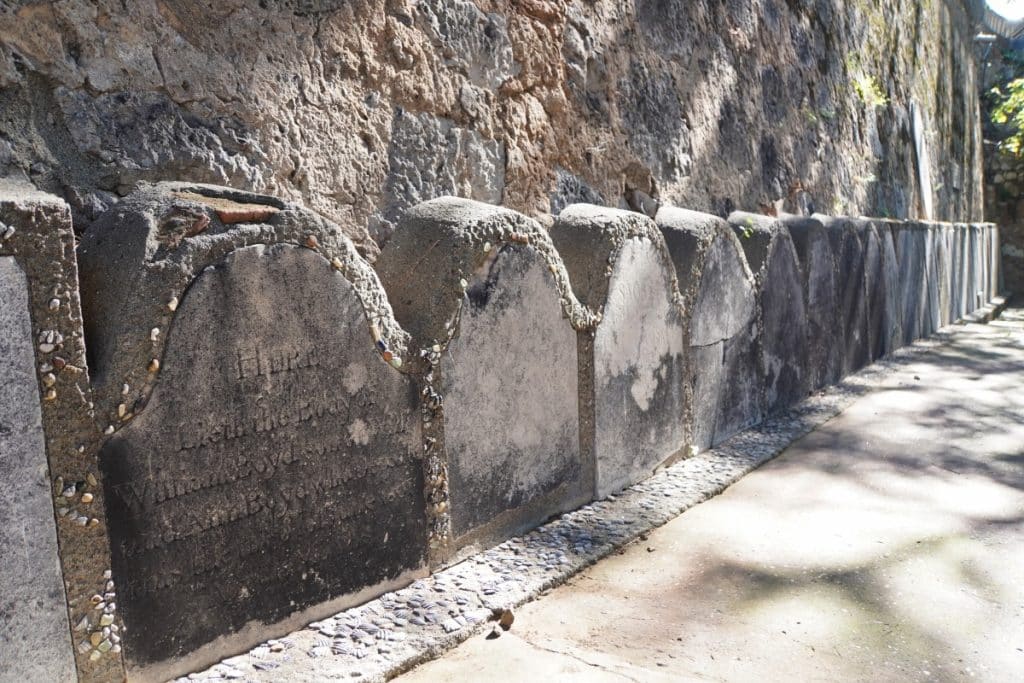We leave the old town through a large gate in the former city wall. Directly behind it are the remains of a former defensive moat in what is probably Gibraltar’s most famous cemetery, the Trafalgar Cemetery.
The triangular property is bordered by Charles V Wall, Prince Edward’s Road and Trafalgar Road. We enter the grounds through a wrought-iron gate. Directly behind it, we discover various information boards that give us a good overview.

History of Trafalgar Cemetery
The cemetery was formerly known as Southport Ditch Cemetery and was consecrated in June 1798. This was seven years before the Battle of Trafalgar, which took place on October 21, 1805. Between 1798 and 1814, the population of Gibraltar used the cemetery for burials. After that, its use was discontinued. There is one exception. A grave from 1838 that is located in the north-eastern corner of the cemetery, near Prince Edward’s Gate.

In 1932, more than a century after the last burial took place in Trafalgar Cemetery, gravestones from St. Jago’s Cemetery were moved to the east wall of Trafalgar Cemetery. The oldest gravestone that I was able to discover on my little tour today dates back to 1738.
Over the years, several additional headstones from the Alameda Gardens were moved, dating from the 1780s.

The site lay fallow for many years. In the 1980s, the gravesites were restored and in 1992 a memorial to the Battle of Trafalgar was created. To this day, the cemetery is the site of an annual commemoration. On the Sunday closest to the anniversary of the Battle of Trafalgar, the dead are commemorated.
Who is buried here?
The cemetery was not renamed to commemorate the Battle of Trafalgar until many years after the victory. You will look almost in vain for the graves of the victims of this battle. There are only two graves where victims of the battle were buried. Both died from injuries sustained during the battle. Captain Thomas Norman of the Royal Marine Corps and HMS Mars was one of the casualties. He died in the naval hospital on December 6, 1805 at the age of 36. The other was Lieutenant William Forster of HMS Colossus, who died of his injuries on October 21, 1805 at the age of 20. Many of the battle’s casualties were buried at sea. Nelson’s remains were brought to England, where he was buried in the crypt of St. Paul’s Cathedral.

Most of the other graves are victims of other naval battles. There are graves of victims of the battles of the French Revolutionary and Napoleonic Wars, but also victims of the First Battle of Algeciras in 1801 and the clashes off Cadiz and Málaga in 1810 and 1812 respectively.
Further graves were laid out for the victims of the three yellow fever epidemics that raged in Gibraltar between 1804 and 1814.
Peace and quiet at Trafalgar Cemetery
After reading up on the history of Trafalgar Cemetery, I set off on a short tour. The grounds are not particularly large and there are well laid out paths. I particularly like how green it is there. No artificial flowers, just shady trees, large bushes and even in November I spot some fresh flowers in the vegetation. If it weren’t for the gravestones, you could almost believe you were standing in a small park.

I don’t seem to be the only visitor who has these thoughts. Visitors sit on the benches everywhere and enjoy the peace and quiet and the shade under the trees. What makes me particularly happy is that the visitors are all very respectful and don’t disturb the atmosphere.
Address:
4JMW+WW9,
Gibraltar GX11 1AA, Gibraltar
Opening hours:
daily: 9am – 9:30pm
Admission price:
free of charge






Leave a Reply